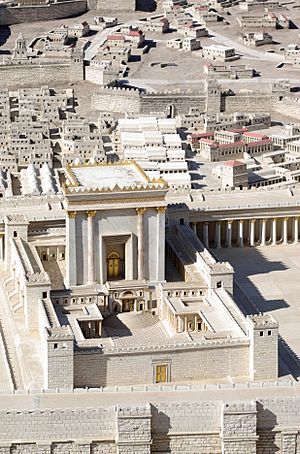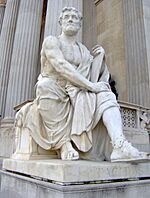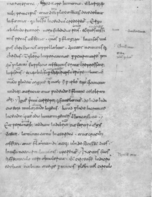Chronology of Jesus facts for kids
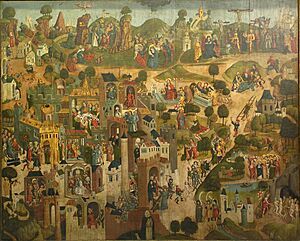
A chronology of Jesus is like a timeline for the important events in the life of Jesus. Experts called scholars use old Jewish and Greco-Roman writings, plus star charts, to figure out when these events happened. They compare these old records with stories from the New Testament in the Bible.
Scholars mostly agree on some general timeframes. They think Jesus was born between 6 and 4 BC. He likely started teaching and gathering followers around AD 28–29. His teaching lasted for one to three years. Most scholars believe Jesus was crucified between AD 30 and AD 36.
Contents
Understanding the Timeline of Jesus' Life
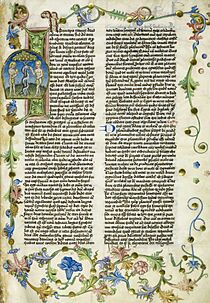
The Christian Gospels (stories about Jesus in the Bible) don't list every single event in Jesus' life. They were written to share important religious ideas, not to be a day-by-day history book. For example, about one-third of the Gospels focus on just the last week of Jesus' life in Jerusalem, known as the Passion of Christ.
Even so, the Gospels do give some clues about dates. These clues can be matched with other historical records. Many old non-Christian writings, like Jewish and Greco-Roman documents, also help. Almost all modern historians agree that Jesus was a real person. They also believe his baptism and crucifixion were real historical events.
By using these methods, scholars usually place Jesus' birth between 6 and 4 BC. They think his public teaching began around AD 27–29 and lasted one to three years. His death is generally thought to have happened between AD 30 and 36.
When Was Jesus Born?
The Bible doesn't give an exact date for Jesus' birth. However, most scholars believe he was born between 6 BC and 4 BC. They use two main ways to figure this out. One way looks at the stories of his birth in the Gospels. These stories mention King Herod's rule. The other way uses the Bible's mention that Jesus was "about 30 years old" when he started teaching.
Figuring Out Jesus' Age When He Started Teaching
The Gospel of Luke 3:23 says Jesus was "about 30 years of age" when he began his work. He started after being baptized by John the Baptist. Luke's Gospel also says John began baptizing in "the fifteenth year of the reign of Tiberius Caesar" (Luke 3:1–2). Scholars believe this was around AD 28–29.
If Jesus was about 30 then, he would have been born around 1-2 BC. If "about 30" meant he was 32, then his birth could fit within King Herod's rule. Herod died in 4 BC.
Another clue comes from the Gospel of John 2:20. It says the Temple in Jerusalem had been under construction for 46 years when Jesus began his work. This also points to the year AD 28–29.
Other Ideas About Jesus' Birth Date
Some people have tried to link the Star of Bethlehem to known events in the sky. For example, one astronomer suggested April 17, 6 BC. This date had a rare alignment of Jupiter in the sky. Other research points to a "comet" seen by Chinese astronomers in March 5 BC. However, none of these sky events perfectly match the Bible's description of the Star of Bethlehem.
When Did Jesus Begin Teaching?
Tiberius Caesar and John the Baptist
One way to estimate when Jesus started teaching is from the Gospel of Luke. Luke 3:1–2 mentions John the Baptist's work. John's work came before Jesus's.
The Bible says:
Now in the fifteenth year of the reign of Tiberius Caesar, Pontius Pilate being governor of Judaea, and Herod being tetrarch of Galilee, and his brother Philip tetrarch of the region of Ituraea and Trachonitis, and Lysanias tetrarch of Abilene, in the highpriesthood of Annas and Caiaphas, the word of God came unto John the son of Zacharias in the wilderness.
Tiberius became emperor in September AD 14. This means John the Baptist's work likely began in late AD 28 or early AD 29. The New Testament says Jesus's baptism by John marked the start of Jesus's public work.
The Temple in Jerusalem and John's Gospel
Another way to guess when Jesus started teaching comes from the Gospel of John. It talks about Jesus visiting Herod's Temple in Jerusalem. This can be compared with historical facts about the Temple's construction.
John 2:13 says Jesus went to the Temple early in his work. In John 2:20, people tell Jesus: "This temple has been under construction for forty-six years."
King Herod started rebuilding the Temple in the 18th year of his rule. This was a huge project that was never fully finished before the Romans destroyed it in AD 70. Because it took 46 years to build, scholars estimate Jesus was teaching around AD 29.
When Was Jesus Crucified?
Pontius Pilate's Time as Governor
All four main Gospels say Jesus was crucified when Pontius Pilate was the Roman governor of Roman Judaea.
The historian Josephus wrote around AD 93 that Jesus was crucified by Pilate's order. Another Roman historian, Tacitus, wrote around AD 116 that Jesus was executed by Pilate during the rule of Emperor Tiberius. Tiberius was emperor from AD 14 to AD 37.
Josephus also tells us that Pontius Pilate was governor from AD 26 until AD 36 or 37. This means Jesus' death must have happened between AD 26 and AD 37.
Herod Antipas's Rule
The Gospel of Luke mentions that Pilate sent Jesus to Herod Antipas for trial. This was because Jesus was from Galilee, which was under Herod's rule. Herod was in Jerusalem at the time.
Herod Antipas was a son of Herod the Great. He was sent away from his rule in AD 39. This means Jesus' death had to happen before AD 39.
Paul's Conversion and the Timeline

Another way to estimate Jesus' death is by looking at when Paul became a Christian. The Bible says Paul's conversion happened some time after Jesus' death.
Paul's conversion is mentioned in his own letters and in the Acts of the Apostles. To figure out when Paul converted, scholars look at his trial before Junius Gallio in Greece. This trial happened around AD 51–52. This date is known from an ancient stone inscription found in Delphi.
Based on this, historians believe Paul converted around AD 33–36. This means Jesus' death happened before this time.
Debate on the Exact Day of Death
Scholars have debated the exact day and hour of Jesus' death for a long time. The Gospels agree that Jesus was crucified on a Friday.
The Gospels of Matthew, Mark, and Luke (called the Synoptic Gospels) suggest the Last Supper was a Passover meal. This would mean the crucifixion was on the 15th day of Nisan (a Jewish month). However, the Gospel of John says Jesus' trial happened before the Passover meal. John places the crucifixion on the 14th day of Nisan. This is the day when the Passover lamb was traditionally sacrificed.
It's hard to make these two accounts perfectly match. Some scholars suggest Jesus and his followers might have used a different calendar. Others think the Gospels might not be giving exact times down to the minute. They might be focusing on the meaning of the events. For example, John's Gospel might present Jesus as the "Lamb of God" by showing him dying at the same time the Passover lambs were killed.
One idea, from Colin Humphreys, suggests that the Gospels use two different calendars. This could explain the differences in dates. However, some experts argue that this idea relies too much on the Bible stories being exact historical records. They say the Bible combines facts with religious meaning.
Resurrection "on the Third Day"
After Jesus was crucified, the Gospels say his tomb was found empty. Then, the Gospels and Paul's letters describe Jesus' resurrection.
The Bible often says Jesus rose "on the third day." For example, Matthew 16:21 says this. However, Matthew 12:40 also mentions Jesus being buried for "three days and three nights."
This might seem confusing. But in ancient times, people often counted days differently. They used "inclusive counting." This means if something happened on Friday, and then again on Sunday, they would count Friday as day one, Saturday as day two, and Sunday as day three. So, "on the third day" could mean after two full days had passed, or that the third day had begun. This is similar to how some languages still say "fifteen days" for two weeks.
Old Estimates of Jesus' Timeline
Over many centuries, different people have tried to estimate the timeline of Jesus' life.
- An early Christian writer named Tertullian (around AD 200) thought Jesus was born in the 41st year of Emperor Augustus's rule and died at age 30 on March 25.
- Another writer, Clement of Alexandria, thought Jesus was born in the 28th year of Augustus.
- Hippolytus (around AD 200) believed Jesus was born on December 25, 3 BC, and died on March 25, AD 29, at age 33.
Anno Domini (AD) Calendar
In AD 525, a monk named Dionysius Exiguus created a way to calculate the date of Easter. He also started a new way of counting years. He said the "present year" was 525 years "since the incarnation of our Lord Jesus Christ." This is where our "AD" (Anno Domini, meaning "in the year of the Lord") calendar system comes from.
Dionysius believed Jesus's birth or conception happened 525 years earlier. It's not fully clear how he figured out Jesus' birth year. He might have used the Gospel of Luke's mention of Jesus being "about thirty years old" during Tiberius's reign.
Later, the historian Venerable Bede in England (around AD 731) used this "Anno Domini" dating system in his famous book, Ecclesiastical History of the English People. This helped make the AD calendar popular. Eventually, Emperor Charlemagne and his successors helped spread this calendar throughout Europe. This is why it's the main calendar system used around the world today.
See also
- Depiction of Jesus
- Historical Jesus
- Life of Jesus in the New Testament
- Timeline of Christianity




